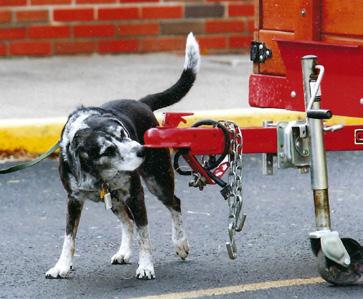
4 minute read
Leading by the Nose
HE’S A “SCENT-SATIONAL” DOG.
That would be Riley, a 6-year-old beagle owned by Dolores Gift, a resident of Masonic Village at Lafayette Hill.
Advertisement
Dolores’ hobby and favorite activity is guiding Riley as he competes in the sport of K9 Nose Work, a detection-style training and competition, which tests your dog’s ability to smell odors.
Like other competitive sports, there is an organizing body, the National Association of Canine Scent Work (NACSW). NACSW is one of the sanctioned organizations where you can earn Nose Work titles and awards.
Dolores’ first dog, Georgie, a hound rescue who passed away two years ago, earned nine titles and ribbons for the sport at various “trials,” or competitions. Over five years, Georgie participated in 15 to 20 trials. At the trials, the dogs compete at different levels to locate scents hidden in various places.
“All dogs have this fantastic ability to sniff things out,” Dolores said. “It’s just natural for them. I’m always practicing with him at home. It’s so much fun to watch. When he finds the odor, he gets a treat. He loves it.”
Dolores initially became involved with scent work because Georgie was a challenge to walk and fearful of other dogs. She hired a trainer to come to her house and work with the dog. The trainer noted during one of the training sessions that Georgie’s nose was always “in the ground.” She mentioned to Dolores she might want to get the dog involved in scent work. And the rest was history.
“Dogs’ noses can smell so much more than we can, like 40 times what we can smell,” Dolores said. “This sport was started by professionals [police officers, trained military] who began training their dogs for bomb sniffing and narcotics. The way professionals train is more intense than what we do, but it’s the same general concept.”
With Georgie, and now Riley, Dolores begins training by placing food in little containers with holes in them and having the dog sniff out the food. After a short time, she then places an odor on a cotton swab in the container (scents like anise, clove and oil of birch, for example), along with the food, and the dog has to sniff out the scent. Eventually, Dolores isolates the scent without any food and hopes the dog will find it.
After proper training was completed, Dolores entered Georgie in trials. The trials consist of four elements: vehicles, interior spaces, exterior spaces and containers. At the first level, the dog has to locate an odor hidden in one of those areas. In level two, he needs to locate two or three odors that are hidden. The dog and handler team needs to successfully find every hidden item in each area within the time limit given.
“The job of the handler or owner is to recognize when the dog is telling you that he found the odor,” Dolores said. “That’s the difficult part. You learn to read your dog and know what your dog is doing and what his body language looks like. He’ll go into a room, start looking around and, all of a sudden, he’ll do an ‘about face,’ and you know he has picked up an odor.”
Her new dog, Riley, is 6 years old and started training for trials a year ago. A beginner, Riley successfully passed an “odor recognition test” and participated in a level one outdoor trial in New Jersey in July.
Dolores has traveled more than six hours to compete or volunteer at a trial. There are typically 30 to 40 dogs that compete and 10 to 15 volunteers who help. The events are not open to the general public.
“The judges are paid, but everyone else volunteers to run the trials,” she said. “You have a volunteer in the parking lot who calls the next dog up, someone who directs you where to go and someone who times the competition, etc.”

Dolores and her “scent-sational” dog, Riley

Dolores loves what she does and has developed a whole network of friends in the scent work community, people she never would have met otherwise. “There are all different age groups, from young people in their 20s to those in their 80s,” she said. “Any dog can be trained to do this. There are a lot of dogs who are not sociable to other dogs, and this sport has been a godsend for them.”
When she’s not training Riley or showing him at a trial, Dolores can be found walking him at the dog park on the Masonic Village campus.
“We just wander around the property, which is amazing,” she said. “There are all kinds of different paths.”
Dolores came to Masonic Village nearly two years ago and calls it “the best decision for this time of my life.” Although her husband was ill and passed away right before moving in, Dolores said she had done her research and found that the village was the right place for them, and subsequently, for her.
“This was the perfect place for us to be, in an apartment, but having the sanctuary of knowing that he could have personal care here if and when he needed it,” she said. “Of all the places we looked, this was the absolute best.”

Georgie participating in a K9 Nose Work trial








